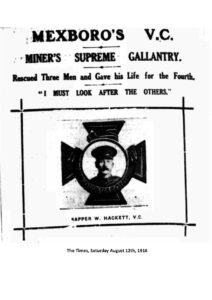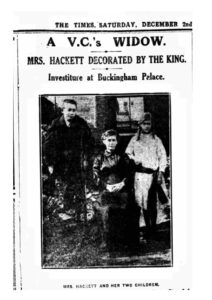SAPPER WILLIAM HACKETT VC

Sapper William Hackett, photograph from The Times, 16th August, 1916. Newspaper image © The British Library Board. All rights reserved. With thanks to The British Newspaper Archive (www.britishnewspaperarchive.co.uk.
For his act of selfless valour William Hackett was awarded a posthumous Victoria Cross – the only such decoration ever to be bestowed upon a Tunneller. He is remembered in perpetuity on Panel 1 of the Ploegsteert Memorial to the Missing near Armentières
We thank the Tunnellers Memorial website for this report –Tunnellers Memorial | A memorial to William Hackett VC and the Tunnelling Companies of the First World War
“On the morning of 22 June 1916, Sapper William Hackett and four other miners of 254 Tunnelling Company were driving a tunnel towards the enemy lines below the cratered surface of the Givenchy sector of northern France. At about one-quarter of the way towards the German trenches at a depth of about 35 feet, the timbered gallery 4’3” high by 2’6” wide was still in the early stages of development; it was served by a single shaft – the Shaftesbury Shaft.
“At 2.50am the explosion of a heavy German mine (the Red Dragon) blew in 25 feet of the tunnel, cutting the five men off from the shaft and safety. On the surface, a rescue party was immediately organised. After two days of digging an escape hole was formed through the fallen earth and broken timbers, and the tunnellers contacted. William Hackett helped three men to safety. However, with sanctuary beckoning, and although himself apparently unhurt, he refused to leave until the last man, seriously injured 22 year-old Thomas Collins of the Swansea Pals (14th Battalion, the Welsh Regiment), was rescued. His words were said to be,
“I am a tunneller, I must look after the others first”.
“The rescuers worked on, but were frequently immobilized by German shelling and mortaring of the shaft-head. Conditions above and below ground became more treacherous by the minute. Eventually the gallery collapsed again, entombing the two men. Both still lie beneath the fields of Givenchy today.”
“William Hackett, one of two sons of John and Harriet Hackett, was born on 11th June 1873 in Patriot Street, Sneinton near Nottingham. Father John was a travelling brewer, who “did considerable business among country-side inns of the old-fashioned type” [Mexborough and Swinton Times]. William did not go to school and was to remain illiterate throughout his life. Leaving his first job in a factory in Nottingham, at the age of eighteen he applied for mining work at Denaby Main, a large local colliery founded in 1863.
“On 16th April 1900 at Conisbrough Parish Church, he married Alice Tooby, formerly of Morley near Leeds. The couple moved into 22, Cusworth Street, Denaby, one of many small terraced houses owned by the colliery. In 1901 William is listed as a ‘Coal Miner’s Filler’, a job that entailed loading ‘tubs’ (mine trucks) with mineral. Some years later, and having found better-paid work at Manvers Main Colliery, the Hacketts, now a family, had left Denaby for Mexborough near Doncaster, South Yorkshire. William and Alice, their son Arthur and daughter Mary, as well as mother and father-in-law Thomas & Sarah Tooby, were settled in a new home at 49, Crossgate. William’s job was now that of ‘Dataller’, making and repairing roads and railways underground.
“Upon the declaration of war in August 1914 William Hackett began the quest to ‘do his bit’. Three times he tried and failed to enlist in the York and Lancaster Regiment – at the age of 41 he was considered too old for the infantry. The desperate need for skilled miners on the Western Front, however, saw notices requesting volunteer tunnellers being posted in collieries, mineral mines and quarries across the land. On 25th October 1915, despite having been being diagnosed with a heart condition by the army medicals, Hackett was accepted by the Royal Engineers, and after a fortnight’s training at Chatham followed by a few days leave, he was sent to France to join 172 Tunnelling Company. Within a month he was transferred to 254 Tunnelling Company, then working on the Western Front at Givenchy lès la Bassée in northern France.
“In January 1916 news of Arthur arrived by letter. At the age of fourteen, he had already left school and begun work – underground at Manvers Main Colliery. After only four weeks he had been involved in an accident with runaway mine trucks. The boy was seriously injured, his right leg having to be amputated below the knee. Being illiterate, William Hackett asked a friend, Sapper I R Evans, to write home for him:
2nd February, 1916
It is very hard to have his leg off but God knows best…its very hard for me to be in this foreign land and have a lad placed in hospital…I cannot help him but I know you will do all you can.”
Following his death William Hackett was awarded a posthumous Victoria Cross which his widow collected from the King. ‘The Times’ reported this as:
“A V.C.’s Widow. Mrs Hackett Decorated by the King. Investiture at Buckingham Palace.”
Newspaper image © The British Library Board. All rights reserved. With thanks to The British Newspaper Archive (www.britishnewspaperarchive.co.uk
For the full report visit the Tunnellers Memorial website: Tunnellers Memorial | A memorial to William Hackett VC and the Tunnelling Companies of the First World War.


